Black and gray is a common color combination for snakes and is found in abundance in nature. Sometimes the snake has multiple other colors along with these two, and sometimes, these are the only colors on the day. Around the world, nearly 40% of black and gray snakes are venomous. So it’s always better to identify the snake first before making any approach.
Today we’ll be talking about both varieties of black and gray snakes. This article discusses ten black and gray snakes while listing the rest.
10 Black and Gray Snakes
1) Gray Rat Snake
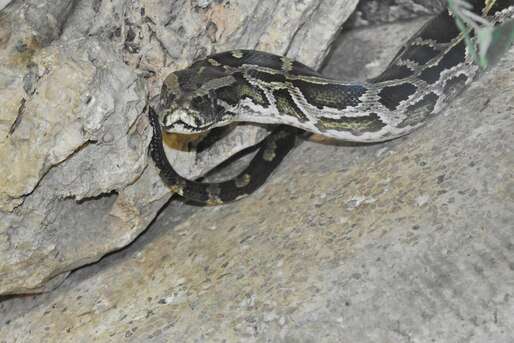
This list of black and gray snakes starts with the Gray Rat Snake. The gray rat snake is a nonvenomous snake species that hunts its prey by scent and subdues them by constricting.
This snake can come in a variety of color ranges, including brown with gray. Another variety is with gray as the background color and splotches of black patterning the whole body. The head is also gray, with a black bar connecting two eyes and two others leaning down the edges.
- Common Name: Central Ratsnake, Chicken Snake, Midland Ratsnake, Pilot Black Snake
- Scientific name: Pantherophis spiloides
- Size: 99 – 183 centimeters
- Location: Eastern and central United States, Canada
2) Nose-Horned Viper
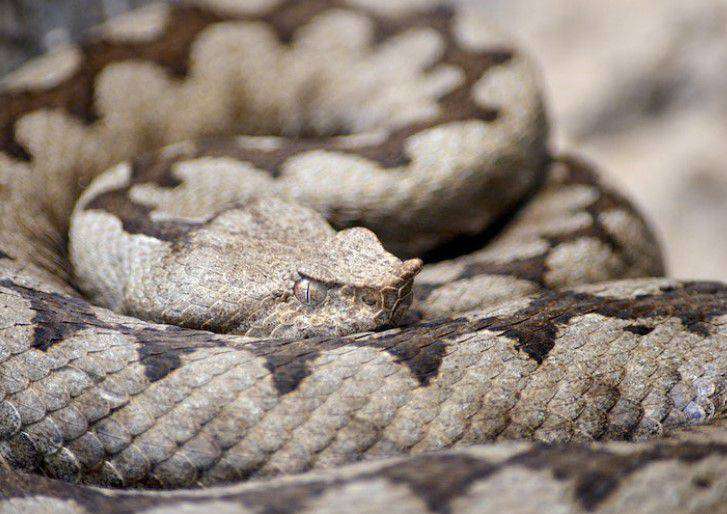
The Nose-Horned Viper is a species of venomous viper found in southern Europe. This snake is highly venomous and possibly the most dangerous snake in Europe. Its venom contains neurotoxins, hemotoxins, and proteolytic agents that cause hemoconcentration and hemorrhage and prevent coagulation.
The species gets its name from the pair of large, supraocular scales over each eye, resembling horns. The base color of the snake ranges from light brown to steel gray. In the case of gray skin, it has continuous, zigzag, black patterns over the length of the body. The head is brown with black splotches.
- Common Name: Long-Nosed Viper, Horned Viper, Sand Viper
- Scientific name: Vipera ammodytes
- Size: 40 – 50 centimeters (16 – 20 inches)
- Location: Italy, Slovenia, Croatia, Bosnia-Herzegovina, Serbia, Montenegro, Albania, Kosovo, North Macedonia, Greece, Austria, Romania, Bulgaria, Turkey, Georgia, Syria
3) Massasauga Rattlesnake
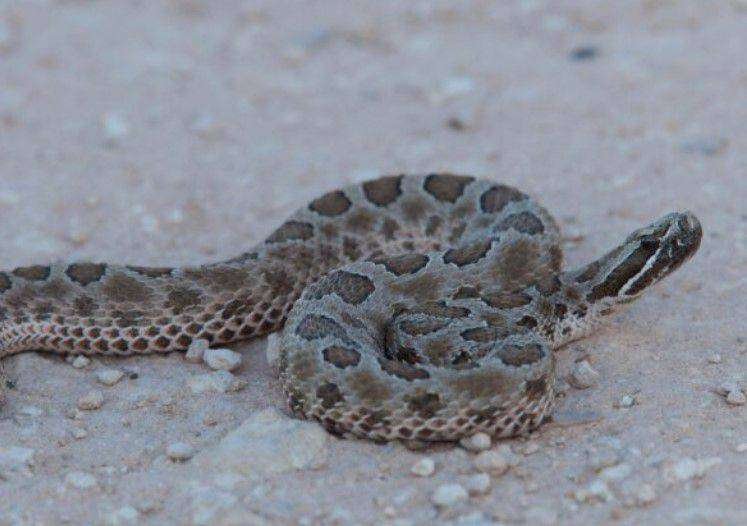
Massasauga Rattlesnake is, like every other rattlesnake, a species of venomous snakes. The venom of this snake contains cytotoxins which destroy the tissues of the bitten. It also contains an enzyme responsible for affecting blood flow and preventing clotting.
Two types of color schemes are seen in this snake. One of them is tan with brown patterns, and the other one is black patterns on gray-colored skin. Some dark splotches on the skin are more faded than others, usually in alternative columns.
- Common Name: The Massasauga, Massasauga Rattler, Black Massasauga, Black Rattler, Black Snapper, Gray Rattlesnake, Little Gray Rattlesnake, Muck Rattler, Prairie Rattlesnake, Spotted Rattler, Swamp Rattler, Dwarf Prairie Rattlesnake, Eastern Massasauga Great Adder, Ground Rattlesnake, Kirtland’s Rattlesnake, Little Black Rattlesnake, Michigan Point Rattler, Prairie Massasauga, Small Prairie Rattlesnake, Snapper, Swamp Massasauga, Swamp Rattlesnake, Triple-Spotted Rattlesnake
- Scientific name: Sistrurus catenatus
- Size: 60 – 75 centimeters (24 – 30 inches)
- Location: United States, Mexico
4) Hook-Nosed Sea Snake
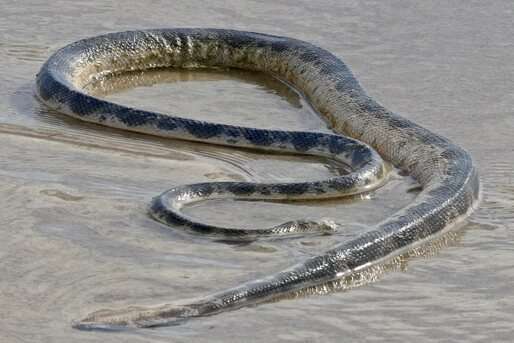
Hook-Nosed Sea Snake, as its name implies, is a species of aquatic snakes found in the Arabian Sea and the Persian Gulf. This snake is highly venomous, and its venom contains neurotoxins and mycotoxins that are fatal for humans. In fact, almost 90% of deaths by sea snake bites are caused by hook-nosed sea snakes.
The hook-nosed sea snake is a long body that is thicker in the middle and narrows towards the head and the tail. The usual coloring of this sea snake is a dark gray with a paler front. In juvenile specimens, the back has black transverse bands on a gray background.
- Common Name: Beaked Sea Snake, Common Sea Snake, Valakadeyan Sea Snake
- Scientific name: Enhydrina schistosa
- Size: 130 centimeters (51 inches)
- Location: Arabian Sea, Persian Gulf, Bahrain, Iran, Iraq, Kuwait, Oman, Qatar, Saudi Arabia and United Arab Emirates, Seychelles, Madagascar, India, Pakistan, Sri Lanka, Bangladesh, Myanmar, Thailand, Vietnam
5) Axanthic Ball Python

Ball Python is, as is every other python, a nonvenomous constrictor snake. It’s the smallest African python and is very popular as a pet. The ball python is called so because of its tendency to curl into a ball when stressed or threatened.
Axanthic Ball Python is a color morph caused by axanthism. Axanthism is a recessive genetic mutation that makes the snake unable to produce xanthophores, i.e., yellow pigments. Axanthic ball python is gray or light brown, marked with black patterns all over the body.
- Common Name: Royal Python
- Scientific name: Python regius
- Size: 3 – 5 feet
- Location: Cameroon, Ghana, Nigeria, Senegal
6) Night Snake
Night Snake is a species of venomous snakes. But its venom is mild and isn’t harmful to humans. The snake only uses venom to subdue its prey. This species of snake is special in the way that it both hibernates during the winter and aestivates during small periods of summer.
The night snake has gray or light brown, or beige, as the background color of the dorsal side with black or brown patterns on it. The ventral side of the snake is uniformly white.
- Scientific name: Hypsiglena torquata
- Size: 30 – 66 centimeters (12 – 26 inches)
- Location: Canada, Mexico, the United States
7) Pale-Headed Snake
Pale-Headed Snake is another nonvenomous snake species on our list of black and gray snakes. The average-sized snake is arboreal, meaning its locomotion is primarily by trees. As a result of this, it mainly feeds on tree frogs.
Pale-headed snakes can be olive or black with a paler ventral side with gray. It has a pale yellow portion on the neck, bordered by black, and a gray-colored head with black streaks. The snake also has a darker vertebral streak.
- Scientific name: Holocephalus bitorquatus
- Size: 51 centimeters (20 inches)
- Location: Cape York Peninsula, Queensland and New South Wales of Australia
8) Chinese Cobra
Chinese Cobra, like all cobras, is a venomous snake species. The venom of this snake is highly potent and contains neurotoxins, cardiotoxins, and cytotoxins.
This aggressive snake attacks fast, and its bite leads to pain, swelling, and necrosis, though death by the snakebite is small in number. The Chinese cobra is also on IUCN’s Red List as a Vulnerable species.
This snake is uniformly black on the dorsal side. Its ventral side of the snake is pale yellow near the mouth, followed by a black portion and then steely gray. The hood is also black with a pale yellow pattern.
- Common Name: Taiwan Cobra
- Scientific name: Naja atra
- Size: 120 – 150 centimeters (3.9 – 4.9 feet)
- Location: China, Taiwan
9) Anerythristic Corn Snake
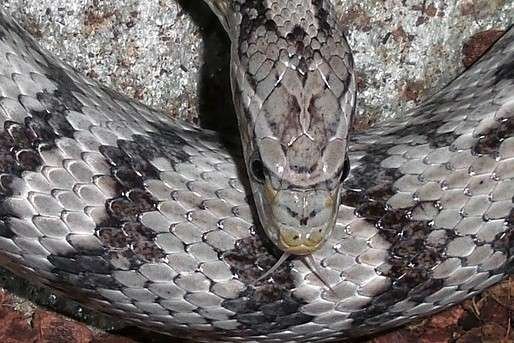
Corn Snake is a species of nonvenomous snakes. It gets its name from the unique checker-like patterns of black and white on its belly that resemble the kernels of corn. This species is also very beneficial to humans since it helps control the population of rodents.
The corn snake is known for its various color and pattern morphs. One of those is the Anerythristic morph, where the snake lacks the erythrin pigments which are responsible for the red, yellow, and orange colors of the skin. As a result, the snake has black and gray on its body.
- Scientific name: Pantherophis guttatus
- Size: 61 – 182 centimeters (2 – 6 feet)
- Location: Southeastern and central United States
10) Gray Snake
On number 10, we have the Gray Snake. It is a species of venomous snake endemic to Australia. The venom of this snake is mild and typically isn’t fatal. It contains procoagulants that cause pain and swelling.
The gray snake, true to its name, is completely gray on the body. The head of the snake is small and has a black patch at the neck. Because of its limited distribution globally, the species is listed as Endangered on IUCN’s Red List.
- Common Name: Dämel’s Snake
- Scientific name: Hemiaspis damelii
- Size: 40 – 50 centimeters
- Location: Queensland, New South Wales and South Australia of Australia
Other Black and Gray Snakes
-
11) Black Ball Python
-
12) Key West Motley Boa
-
13) Ring-Necked Snake*
-
14) Northern Black Racer (Juvenile)
-
15) Eastern Copperhead (Juvenile)*
-
16) Black-Necked Garter Snake
-
17) Coachwhip
-
18) Common Kingsnake
-
19) Eclipse Boa
-
20) King Cobra*
-
21) Long-Nosed Snake
-
22) Gopher Snake
-
23) Common Death Added*
-
24) Saddled Leaf-Nosed Snake
-
25) Smith’s Black-Headed Snake
-
26) Sonoran Whipsnake*
-
27) Western Lyre Snake*
-
28) Western Patch-Nosed Snake
-
29) Harwicke’s Rat Snake
-
30) Glossy Snake
-
31) Mountain Patch-Nosed Snake
-
32) Pygmy Rattlesnake*
-
33) Anery Stripe Tessera Corn Snake
-
34) Desert Striped Whipsnake
-
35) Charcoal Corn Snake
-
36) Blue-Bellied Black Snake*
-
37) Arizona Black Rattlesnake*
-
38) Grass Snake
(*) denotes venomous.
Frequently Asked Questions
1) What is the name of the black and gray snakes found in North Carolina?
Ans. Massasauga Rattlesnake, Coachwhip, Pygmy Rattlesnake, Ring-Necked Snake.
2) What is the name of the black and gray snakes found in Virginia?
Ans. Ring-Necked Snake
3) What is the name of the black and gray snakes found in Texas?
Ans. Gray Rat Snake, Massasauga Rattlesnake, Coachwhip, Ring-Necked Snake, Glossy Snake, Long-Nosed Snake, Striped Whipsnake.
4) Are black and gray snakes venomous?
Ans. Not all black and gray snakes are venomous. Some black and gray snakes, like the Chinese Cobra and the Massasauga Rattlesnake, are venomous while some, like the Corn Snake and the Gray Ratsnake, are nonvenomous.
This article concludes here. Thank you for reading. Please make sure to leave a comment for us, telling us what you thought about it. If you liked it, you might like to take a look at our other similar articles about snakes and other animals. And you didn’t, then be sure to leave some pointers for us to do better next time. We’ll be back with more interesting topics about our nature.
Also Read:
Anamika has a fascination with all living things. Being a Zoology student, she loves to know new interesting things about animals. She’s also a very keen fan of manga and anime. Writing is her passion, and writing about her favorite things is her boost of serotonin.

